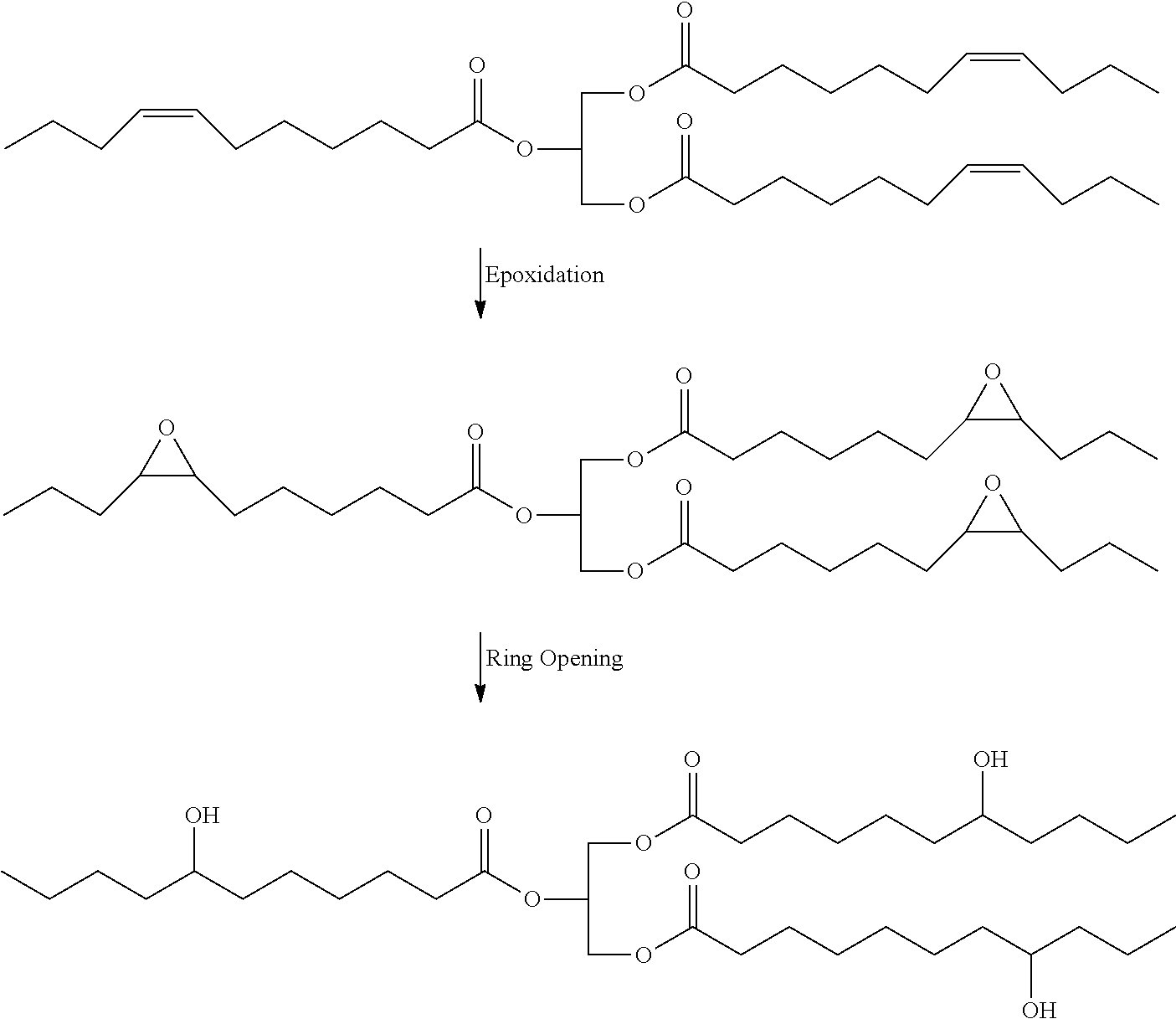High bio content hybrid natural oil polyols and methods therefor
a hybrid, high bio content technology, applied in the direction of other chemical processes, organic chemistry, chemistry apparatus and processes, etc., can solve the problems of unacceptably increasing the viscosity of soy polyols, detrimentally affecting the physical properties of polyurethane products, and poor physical properties of polyurethanes, so as to avoid the challenges and problems inherent in the epoxide synthetic pathway, low cost, and low viscosity
- Summary
- Abstract
- Description
- Claims
- Application Information
AI Technical Summary
Benefits of technology
Problems solved by technology
Method used
Image
Examples
example 1
[0043]
ComponentAmount (grams)Diphenylmethane diisocyanate12.802000 Mr Polyether polyol diol19.20Honey Bee 150 soy polyol68.00
[0044]The above amounts of diphenylmethane diisocyanate and 2000-molecular weight polyether polyol diol were stirred for 2 hours at about 185° F., then cooled to about 120° F. The above amount of Honey Bee 150 soy polyol (MCP Industries, Inc., Corona, Calif., USA), a soy polyol with a hydroxyl number of 150, was added with stirring. The mixture was allowed to react at 180° F. with stirring to give 100.00 grams of polyol with a hydroxyl number of 55.
example 2
[0045]
ComponentAmount (grams)Diphenylmethane diisocyanate12.252000 Mr Polyether polyol diol22.75Honey Bee 150 soy polyol65.00
[0046]The above amounts of diphenylmethane diisocyanate and 2000-molecular weight polyether polyol diol were stirred for 2.5 hours at about 185° F., then cooled to about 120° F. The above amount of Honey Bee 150 soy polyol (MCP Industries, Inc., Corona, Calif., USA), a soy polyol with a hydroxyl number of 150, was added with stirring. The mixture was allowed to react at 180° F. with stirring for an additional 3 hours to give 100.00 grams of polyol with a hydroxyl number of 56.
example 3
[0047]
ComponentAmount (grams)Diphenylmethane diisocyanate41.501000 Mr Polyether polyol diol58.50Honey Bee 150 soy polyol185.71
[0048]The above amounts of diphenylmethane diisocyanate and 1000-molecular weight polyether polyol diol were stirred for 2 hours at about 180° F., then cooled to about 120° F. The above amount of Honey Bee 150 soy polyol (MCP Industries, Inc., Corona, Calif., USA), a soy polyol with a hydroxyl number of 150, was added with stirring. The mixture was allowed to react at 180° F. with stirring for an additional 3 hours to give 285.71 grams of polyol with a hydroxyl number of 55.
PUM
| Property | Measurement | Unit |
|---|---|---|
| temperature | aaaaa | aaaaa |
| temperature | aaaaa | aaaaa |
| temperature | aaaaa | aaaaa |
Abstract
Description
Claims
Application Information
 Login to View More
Login to View More - R&D
- Intellectual Property
- Life Sciences
- Materials
- Tech Scout
- Unparalleled Data Quality
- Higher Quality Content
- 60% Fewer Hallucinations
Browse by: Latest US Patents, China's latest patents, Technical Efficacy Thesaurus, Application Domain, Technology Topic, Popular Technical Reports.
© 2025 PatSnap. All rights reserved.Legal|Privacy policy|Modern Slavery Act Transparency Statement|Sitemap|About US| Contact US: help@patsnap.com



